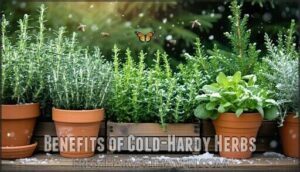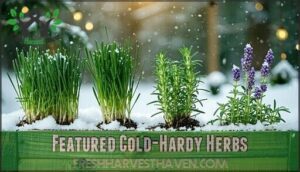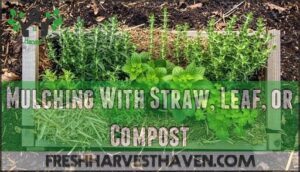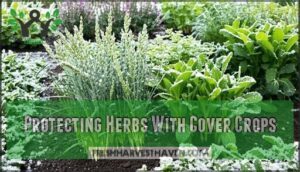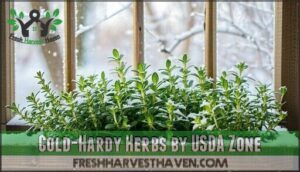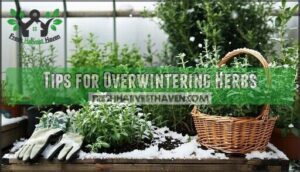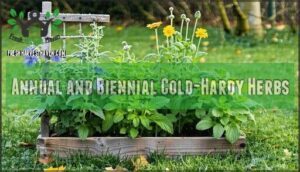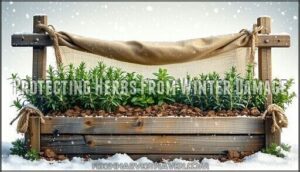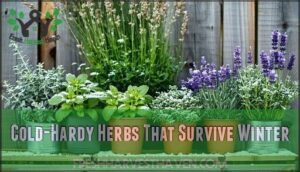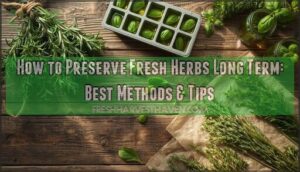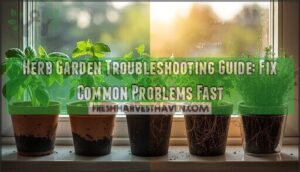This site is supported by our readers. We may earn a commission, at no cost to you, if you purchase through links.
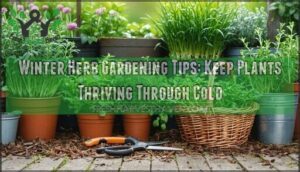 Winter herb gardening tips can keep your culinary favorites thriving even when temperatures drop.
Winter herb gardening tips can keep your culinary favorites thriving even when temperatures drop.
Start by choosing cold-hardy varieties like chives, thyme, and rosemary—they’re tough enough to handle frost without throwing in the towel.
Apply a thick layer of mulch around plants to insulate roots and prevent freeze-thaw cycles that damage tender growth.
For borderline-hardy herbs, use frost blankets or move containers to protected spots near south-facing walls.
Don’t forget to harvest what you can before hard freezes hit—dried herbs taste better than frozen disappointment.
Smart planning and proper protection make the difference between winter success and spring regret.
Table Of Contents
- Key Takeaways
- Preparing Herbs for Winter
- Benefits of Cold-Hardy Herbs
- Featured Cold-Hardy Herbs
- Overwintering Techniques for Herbs
- Cold-Hardy Herbs by USDA Zone
- Moving Herbs Indoors for Winter
- Tips for Overwintering Herbs
- Annual and Biennial Cold-Hardy Herbs
- Protecting Herbs From Winter Damage
- Cold-Hardy Herbs That Survive Winter
- Frequently Asked Questions (FAQs)
- How do you care for herbs in winter?
- How do I prepare my herb garden for winter?
- Can you grow herbs in winter?
- How do I protect my outdoor herbs during the winter season?
- Which winter herbs work best outdoors?
- Can you grow tender herbs outdoors during the winter season?
- What should I do with my herbs in the winter?
- What herbs should be cut back for winter?
- What is the best herb to grow in winter?
- What temperature is too cold for herbs?
- Conclusion
Key Takeaways
- Choose cold-hardy varieties like chives, thyme, and rosemary that can handle frost without protection, while moving tender herbs indoors before freezing temperatures hit.
- Apply thick mulch after the first hard frost to insulate roots and prevent damaging freeze-thaw cycles, keeping mulch 1-2 inches away from stems to avoid rot.
- Time your harvest properly by cutting herbs in the morning when essential oils peak, then dry them completely before storing in airtight containers for winter use.
- Use protective covers like frost blankets or move containers to sheltered areas near south-facing walls when temperatures drop below your herbs’ tolerance levels.
Preparing Herbs for Winter
Winter preparation determines whether your herbs survive freezing temperatures and thrive again next spring.
You’ll need to time your harvest, adjust care routines, and apply protective measures before the first hard frost hits your garden.
Harvesting and Drying Perennial Herbs
Success in winter herb gardening depends on proper harvest timing and herb preservation techniques.
Winter herb success starts with perfect timing—harvest before the first hard frost hits.
You’ll want to cut hardy perennial herbs back to 4-6 inches after the first frost, allowing them time to heal before winter’s harsh grip takes hold.
Harvest timing is vital for maximum flavor retention. Morning harvests capture essential oils at their peak concentration, guaranteeing superior herb quality. Use clean, sharp pruning shears to prevent disease transmission between plants—think of it as giving your herbs a professional trim rather than a rough chop.
For effective drying methods and herb storage, follow these proven techniques:
- Bundle herbs loosely to ensure proper air circulation and prevent mold development
- Hang bundles in warm, dry, well-ventilated areas away from direct sunlight
- Store completely dried herbs in airtight containers for extended freshness
- Label containers with harvest dates to track potency over time
Proper herb preservation methods guarantee you’ll enjoy garden-fresh flavors throughout winter. Whether you’re using traditional air-drying or exploring freeze drying options, these winter herb care practices will keep your culinary arsenal well-stocked. Understanding the herb drying process is essential for maintaining flavor and aroma in your herbs.
Managing Annual Herbs for Seed Saving
While you’ve mastered preserving perennial herbs through drying, annual herbs offer another path to garden continuity through seed saving. Transform your annual herbs into next year’s garden by collecting seeds at peak maturity.
Watch for brown, papery seed heads that rattle when shaken—your signal for seed harvesting. Cilantro pods turn tan, dill umbels dry completely, and basil flowers develop dark seeds. Cut stems on dry mornings, then shake over paper to release seeds.
| Herb | Seed Ready Signs | Storage Method |
|---|---|---|
| Cilantro | Brown, split pods | Paper envelopes |
| Dill | Tan, dry umbels | Glass jars |
| Basil | Dark, firm seeds | Sealed containers |
Clean seeds thoroughly, removing chaff and debris. Store in labeled paper envelopes in cool, dry locations. Test viability annually—most herb seed saving maintains 2-3 years of reliability with proper seed storage techniques.
Best Practices for Mulching Herbs
Mulching your herbs properly transforms them from vulnerable winter casualties into thriving survivors.
Smart mulching turns winter herb casualties into garden survivors.
You’ll want to apply organic mulch like wood chips, shredded leaves, or compost after the first hard frost hits—this timing prevents rodents from making cozy winter homes in your herb garden mulch insulation.
Mulch materials should be 3-4 inches deep around each plant, but here’s the key: maintain a 1-2 inch buffer zone from stems.
This prevents rot while providing soil insulation and root protection.
Think of it as tucking your herbs into bed without suffocating them.
Organic mulching offers multiple benefits beyond frost prevention.
It suppresses weeds, retains moisture, and slowly releases nutrients as it breaks down.
Pine needles work excellently for acid-loving herbs, while coarse compost optimizes air exchange.
Your winter herb gardening success depends on this simple yet powerful technique.
Proper mulching stabilizes soil temperature, creating a protective barrier that turns ordinary herbs into winter warriors ready to emerge strong come spring.
Benefits of Cold-Hardy Herbs
Cold-hardy herbs offer year-round culinary treasures and garden beauty, providing fresh flavors even when your summer annuals have called it quits.
These resilient plants also attract beneficial insects and pollinators throughout the growing season, creating a thriving ecosystem that supports your entire garden’s health.
Year-Round Culinary and Ornamental Value
Once your herbs are properly prepared for winter, you’ll discover their incredible value extends far beyond basic survival.
Cold-hardy herbs offer exceptional Herb Garden Design opportunities that deliver both Culinary Uses and Ornamental Value throughout winter months.
Your yearround herb garden becomes a living showcase with these hardy champions.
Seasonal Interest peaks when other plants fade, making smart Garden Planning essential for continuous beauty and harvest.
Winter herb gardening transforms your space into a functional masterpiece:
- Rosemary’s evergreen needles provide structure while flavoring winter roasts
- Thyme’s woody stems create striking contrast against snow and ice
- Sage’s silvery leaves capture frost, forming natural garden sculptures
- Oregano’s dense mat prevents soil erosion while supplying pizza toppings
- Lavender’s fragrant foliage brightens dreary days and scents winter bouquets
These Ornamental Herb Types guarantee your garden stays productive and beautiful year-round.
By choosing the right winter hardy herbs, you can enjoy a thriving garden even in the coldest months.
Attracting Pollinators and Beneficial Insects
Beyond their culinary value, your cold-hardy herbs become winter refuges for beneficial insects.
These pollinator plants and insect attractors create essential habitat when other food sources disappear.
| Herb | Winter Benefit for Insects |
|---|---|
| Oregano & Thyme | Dense foliage shelters ladybugs |
| Lavender & Sage | Woody stems house parasitic wasps |
| Chives & Mint | Ground cover protects beneficial beetles |
| Rosemary | Evergreen structure provides wind protection |
| Fennel | Seed heads feed overwintering birds |
Bee friendly herbs like oregano continue attracting pollinators during mild winter days.
This companion planting strategy builds herb garden biodiversity that supports natural pest control year-round.
When spring arrives, your overwintering beneficial insects emerge ready to tackle garden pests.
These herb companions reduce your need for chemical interventions while maintaining pollinator attraction throughout the growing season.
Featured Cold-Hardy Herbs
You’ll want to focus on these four standout cold-hardy herbs that can handle winter’s worst while still delivering fresh flavors.
Each brings unique growing requirements and rewards, from chives‘ reliable spring comeback to rosemary’s year-round aromatic presence.
Chives – Growing and Caring Tips
Every seasoned gardener knows that chives are the ultimate cold weather herbs for beginners. These hardy perennials tolerate temperatures down to -40°F, making them perfect for herb gardening 101 enthusiasts. Chive varieties include common onion chives and elegant garlic chives with white flowers.
Chive planting succeeds with these essential steps:
- Choose well-draining soil with pH 6.0-7.0 for ideal soil requirements
- Water consistently but avoid waterlogged conditions
- Apply light fertilization tips every 2-4 weeks during growing season
- Use proper pruning techniques by cutting leaves at the base
- Master harvest methods by snipping outer leaves first
Chive propagation happens naturally through division every 2-3 years. Watch for chive pests like aphids, though their strong scent deters most insects. These reliable perennials overwinter beautifully with minimal mulching, giving you fresh herbs when other plants sleep.
For a successful harvest, understanding chive growing conditions is vital to maximize yields and flavor.
Tarragon – Varieties and Growing Conditions
Growing tarragon successfully means understanding the key differences between Tarragon Types. French Tarragon delivers that coveted anise flavor but won’t grow from seed, while Russian Tarragon handles harsh winters better yet lacks the culinary punch.
| Variety | Hardiness Zone | Flavor Profile |
|---|---|---|
| French Tarragon | 4-8 | Rich anise notes |
| Russian Tarragon | 3-8 | Mild, less flavorful |
| Mexican Tarragon | 8-11 | Sweet anise taste |
Tarragon Care requires well-draining soil with slightly alkaline pH. Tarragon Planting works best through spring division or cuttings since French varieties don’t produce viable seeds.
These cold weather herbs thrive in your herb garden maintenance routine when you provide proper drainage to prevent root rot. Both varieties adapt well to indoor growing during winter months, making them perfect additions to your winter herb gardening tips arsenal.
Rosemary – Evergreen Foliage and Lemon Scent
Mediterranean rosemary transforms your winter herb gardening efforts with its needle-like evergreen boughs that withstand freezing temperatures.
This fragrant herb offers exceptional cold hardiness in zones 7-10, with ‘Arp’ varieties surviving zone 6 conditions.
Rosemary care involves minimal evergreen pruning and strategic mulching for herb winterization.
You’ll appreciate its lemon uses in cooking while enjoying winter harvesting from December through March.
The camphor-scented foliage releases oils when touched, making it perfect for culinary adventures during cold months when fresh herbs become scarce.
Oregano – Delicate Foliage and Tiny Blooms
Unlike flashy rosemary, oregano quietly delivers in your winter herb garden. This low-growing Mediterranean herb forms dense mats that handle cold weather with surprising toughness.
Greek oregano offers the best flavor for winter herb gardening, while common varieties provide reliable cold hardiness. During summer, oregano produces delicate blooms that attract beneficial insects before settling into winter mode.
Your oregano care routine should include:
- Cutting back one-third of growth after first frost for frost protection
- Applying 3-4 inches of mulch around the base for herb winterization
- Regular oregano harvest to encourage compact, protected growth.
Smart oregano pruning keeps plants productive through winter’s challenges.
Overwintering Techniques for Herbs
You’ll need effective overwintering techniques to keep your herbs healthy through winter’s harsh conditions.
Smart protection methods like frost blankets, mulching, and cover crops can mean the difference between thriving plants and garden casualties come spring.
Using Frost Blankets and Covers
When cold weather threatens your herb garden, frost blankets and covers become your plants’ best friends.
These protective barriers trap warm air around your herbs while allowing proper ventilation, creating cozy microclimates that shield against freezing temperatures.
Using the right frost protection methods is essential for maintaining a healthy herb garden during winter.
| Protection Type | Temperature Range |
|---|---|
| Lightweight row covers | Down to 28°F |
| Heavy frost blankets | Down to 20°F |
| Cold frames | Down to 15°F |
| Burlap wraps | Light frost protection |
Install covers using hoops or stakes, securing edges with rocks or clips.
Remove during warm days to prevent overheating and restore when temperatures drop.
Mulching With Straw, Leaf, or Compost
Why settle for basic winter protection when you can master the art of organic mulching? The right mulch creates a thermal barrier that keeps your herbs thriving through harsh conditions.
Straw insulation provides excellent air pockets that trap warmth around root systems, maintaining soil temperatures 5–10°F warmer than bare ground. Leaf mulch forms a dense mat that shields roots from damaging freezes while slowly decomposing to enrich your soil.
Compost benefits include immediate nutrient release and consistent temperature regulation throughout winter. Your mulching arsenal should include:
- Straw – Clean, seed-free insulation that won’t introduce weeds
- Shredded leaves – Free yard waste that creates perfect winter protection
- Aged compost – Nutrient-rich thermal blanket for soil health
- Pine needles – Ideal for acid-loving herbs like rosemary
- Bark chips – Long-lasting protection with attractive appearance
Apply organic matter 2–3 inches deep after the first hard freeze, keeping mulch away from plant stems to prevent rot. This organic mulch reduces soil evaporation by 70% while supporting beneficial microbial activity.
Protecting Herbs With Cover Crops
Transform your herb garden into a winter fortress with cover cropping – nature’s ultimate multitasking solution.
Plant winter rye, crimson clover, or hairy vetch between herb rows after fall harvest to create living protection that beats traditional mulch.
Smart Crop Selection means choosing winterhardy crops that establish before frost.
Soil Preparation involves seeding by late October for proper root development.
These green guardians deliver Cover Crop Benefits through soil health support and erosion protection.
Your herbs receive Herb Protection while cover crops work underground, fixing nitrogen and preventing nutrient loss.
Come spring, decomposing plants provide organic matter enhancement that supercharges herb growth.
Winter Mulching becomes effortless when nature does the heavy lifting.
Cold-Hardy Herbs by USDA Zone
Your herb garden’s winter survival depends on choosing plants that match your specific USDA hardiness zone.
Each zone supports different cold-hardy herbs that can withstand local winter temperatures and thrive year after year.
Zone 4 – Chives, Garlic Chives, and Lovage
Zone 4 gardeners can rely on three powerhouse perennials that shrug off -30°F temperatures with ease.
These hardy champions require minimal winter herb gardening effort while delivering maximum flavor rewards.
Chive Care involves cutting plants to 1 inch above soil before applying thick winter mulching for enhanced cold weather plants protection:
- Chives – Purple blooms and mild onion flavor, surviving -40°F with reliable spring regrowth
- Garlic chives – White flowers attract pollinators while providing robust garlic notes for winter cooking
- Lovage – Towering 6-foot giant offers celery-like flavor, perfect for hearty soups and stews
- Frost protection – Simple mulching provides adequate herb garden winter care for these coldhardy herbs
These winter hardiness champions enter natural dormancy, strengthening their root systems for vigorous Lovage Growth and spring recovery.
Zone 5 – Cilantro, Dill, and Lavender
Moving beyond the basics, Zone 5 gardeners can successfully grow three versatile herbs that laugh in the face of -20°F temperatures.
Smart cilantro care involves winter sowing since cool weather prevents the dreaded bolting that ruins summer crops.
Dill harvest becomes effortless when you let plants self-seed naturally, creating next year’s garden without lifting a finger.
Lavender pruning matters less than drainage—soggy roots kill faster than arctic winds.
Apply winter mulching around these beauties, but keep mulch away from lavender stems.
Use frost protection like row covers during extreme cold snaps, and position plants near south-facing walls for bonus warmth.
Zone 6 – Angelica, Catnip, and Rosemary
Gardening in Zone 6 opens doors to three exceptional hardy perennials that’ll weather winter’s harshest conditions. Your winter herb gardening tips start with smart plant selection and strategic placement.
- Angelica Growth reaches towering 6-foot heights – harvest stems for candied treats and roots for medicinal preparations
- Catnip Harvest provides dual benefits: soothing teas for humans while attracting beneficial pollinators to your garden
- Rosemary Care thrives against south-facing walls where zone 7 microclimates create Frost Protection naturally
These hardy perennials need Winter Pruning after first hard freeze, then mulch heavily for winter herb care success.
Zone 7 – Bay Laurel, Bee Balm, and Fennel
Within Zone 7’s generous temperature range, you’ll discover herbs that thrive despite winter’s occasional bite.
Bay Laurel needs wind protection and well-draining soil—soggy roots spell disaster. Position it near south-facing walls where Zone 7 Microclimates create warmer pockets.
Bee Balm Varieties like ‘Jacob Cline’ attract beneficial insects while tolerating frost. Apply Winter Mulch around bases after first freeze for Frost Protection.
Fennel Propagation succeeds easily, but keep it away from other herbs—it’s a notorious garden bully. Herb Pruning should wait until spring for these tender perennials.
Fennel Care requires cutting back spent flower heads to prevent aggressive self-seeding throughout your garden. Understanding herb hardiness zones is essential for the survival of these plants in Zone 7.
Moving Herbs Indoors for Winter
You can successfully grow many herbs indoors during winter with proper planning and care.
The key is selecting suitable varieties and providing adequate light, which often means adding grow lights to supplement shorter daylight hours.
Choosing The Right Herbs for Indoor Growing
Success with indoor herb gardening starts with choosing herbs that adapt to your home’s conditions.
Your indoor herb garden thrives when you select varieties proven to handle indoor environments.
These cold hardy herbs excel in herb potting for winter:
- Chives, oregano, and thyme – tolerate lower light levels and forgive watering mistakes
- Rosemary and sage – require well-drained soil but reward you with year-round harvests
- Mint and parsley – adapt quickly to containers and maintain flavor indoors
Smart indoor herb selection means avoiding finicky annuals like cilantro and dill that struggle with humidity control and soil temperature changes.
Providing Ample Sunlight and Supplemental Lighting
Your herbs crave bright light to survive winter’s darker days. Position plants within 12 inches of a south-facing window for maximum natural light exposure. Sunlight requirements vary, but most herbs need 6-8 hours of bright light daily.
LED growers become essential when indoor sunlight falls short. Mount full-spectrum fixtures 6-12 inches above plants, targeting blue and red wavelengths that fuel photosynthesis.
| Herb Type | Daily Light Hours | Best Light Source |
|---|---|---|
| Basil | 10-12 hours | LED + window light |
| Rosemary | 6-8 hours | South window preferred |
| Mint | 8-10 hours | Supplemental grow light |
Using proper LED grow lights can substantially enhance plant growth. Set timers for 12-18 hours of supplemental lighting during winter months. Indoor growing success depends on consistent light schedules. Monitor your plants’ response – leggy growth signals insufficient light, while compact, vibrant foliage indicates proper illumination.
Tips for Overwintering Herbs
Successfully overwintering herbs requires strategic protection and proper timing for best results. You’ll need to master three key techniques: mulching, season-extending structures, and smart pruning practices.
Mulching With Pine Needles or Bark Mulch
Right mulch choices can make or break your winter herb garden success.
Pine needles create natural acid-loving conditions while slowly breaking down for long-term soil benefits.
Bark mulch offers superior moisture retention and temperature regulation throughout harsh winter months.
- Pine Needle Mulch: Gradually acidifies soil while providing excellent winter insulation for herb roots
- Bark Mulch Benefits: Hardwood varieties retain moisture better than softwood for superior soil protection
- Organic Mulching: Apply 2-3 inches around plants, keeping mulch away from stems to prevent rot
Using Cloches, Cold Frames, and Hoop Tunnels
Beyond pine needles and bark mulch, three protective structures offer superior frost protection for your herbs. These season extension tools create controlled microclimates that keep plants thriving through harsh winters.
| Structure | Coverage | Temperature Boost | Best For |
|---|---|---|---|
| Cloche | Individual plants | Up to 18°F warmer | Rosemary, tender herbs |
| Cold Frame | Small bed areas | 1.5 zones warmer | Multiple herb varieties |
| Hoop Tunnel | Entire garden rows | 2-15°F increase | Large herb collections |
| Row Cover | Flexible coverage | 4-8°F protection | Quick frost defense |
Cloches work like mini-greenhouses, trapping warm air around single plants. You can craft them from milk jugs or buy commercial versions, often featuring cloche cover materials for added protection.
Cold frames offer tunnel gardening benefits with removable tops for ventilation. Position them facing south for maximum sun exposure.
Hoop tunnels provide the most versatile winter harvest solution. Install them over raised beds using PVC pipes and plastic sheeting.
These cold frame tips guarantee success: ventilate on sunny days to prevent overheating, and anchor structures against wind damage.
Trimming Herbs Before Mulching
Through proper winter trimming, you’ll set your herbs up for healthy spring growth. Cut perennial herbs to 4-6 inches after the first frost using clean, sharp pruning techniques. This herb cutting height prevents winter damage while encouraging robust regrowth.
Mulch timing follows immediately after trimming for essential frost protection. Wait for the first hard frost before applying your protective mulch layer.
- Sanitize tools between different herb species to prevent disease spread
- Remove any diseased or damaged stems during your winter herb gardening routine
Proper container size selection is vital for the health and survival of herbs during winter.
Annual and Biennial Cold-Hardy Herbs
While many annual and biennial herbs can’t survive freezing temperatures, some hardy varieties like borage, calendula, and chervil actually thrive in cooler weather and can provide fresh harvests well into winter.
These cold-tolerant champions often taste better after a light frost, making them perfect additions to your winter herb garden.
Borage, Calendula, and Chervil
Annual herbs bring year-round value to your winter garden through smart planning. Borage care involves letting plants self-seed for next year’s pollinators, while calendula benefits include edible petals that brighten winter meals. Chervil recipes showcase its delicate anise flavor in soups and salads.
These hardy annuals excel at herb winter care:
- Borage attracts beneficial insects with stunning blue star-shaped flowers
- Calendula provides natural food coloring and anti-inflammatory properties
- Chervil offers continuous harvests when succession planted every two weeks
- All three readily self-seed, ensuring herb companions return without replanting effort
To guarantee the health of these herbs during colder months, understanding proper container insulation is vital for their survival.
Angelica, Caraway, and Clary
While borage and calendula brighten winter gardens with their cheerful blooms, these biennial powerhouses offer unique benefits for your winter herb gardening adventures.
Angelica Care starts with rich, moist soil and partial shade – this towering herb can reach six feet when happy. Caraway Harvest begins in the second year when umbrella-shaped flower heads develop aromatic seeds perfect for bread and cooking. Clary Planting works best in fall, allowing roots to establish before winter’s grip takes hold.
These biennials excel at Seed Saving and provide excellent Frost Protection for smaller plants nearby.
Here’s what makes each special:
- Angelica: Hollow stems become candied holiday treats
- Caraway: Feathery foliage protects developing seeds
- Clary: Fuzzy leaves create natural frost barriers
- Herb Cultivation Tips: All three shift smoothly between outdoor beds and indoor containers
Proper mulching strengthens their roots for successful overwintering in your winter garden.
Protecting Herbs From Winter Damage
Winter damage threatens even hardy herbs, but you can protect them with simple strategies.
Use evergreen boughs as natural mulch and set up wind barriers with tarps or burlap to shield your plants from harsh conditions.
Mulching With Evergreen Boughs
When winter arrives, evergreen boughs become your herb garden’s best friend. These natural insulators create perfect Winter Protection for frost sensitive herbs through superior Bough Insulation.
The following table compares different types of evergreen boughs for insulation:
| Evergreen Type | Insulation Rating | Decomposition Speed | Cost |
|---|---|---|---|
| Pine Boughs | Excellent | Slow | Free |
| Fir Branches | Superior | Very Slow | Free |
| Spruce Limbs | Good | Medium | Free |
| Cedar Fronds | Excellent | Slow | Free |
Apply Evergreen Mulch after Christmas tree disposal for free Soil Cover. Layer branches loosely over dormant herbs, creating air pockets that trap warmth while allowing moisture drainage. This Frost Guard system beats traditional mulch by maintaining consistent soil temperatures and preventing freeze-thaw cycles that damage roots.
Providing Wind Protection With Tarps or Burlap
Beyond mulching, wind barriers create essential frost protection for your herbs.
Burlap wrapping around stakes reduces wind speed by 50-60%, preventing dehydration and winter burn.
Tarp installation with proper windbreak placement shields plants from harsh gusts while allowing air circulation.
Smart winter herb gardening protection strategies:
- Secure tarp materials with garden clips or twine
- Install burlap plant protectors on windward sides
- Position frost blankets 6 inches taller than plants
- Create winter shielding without blocking airflow
- Remove barriers when temperatures stay above 28°F
Cold-Hardy Herbs That Survive Winter
Many cold-hardy herbs can survive winter outdoors with proper care, eliminating the need to bring every plant indoors.
These resilient herbs include mint, chives, thyme, oregano, and sage, though lavender requires special attention to prevent moisture damage during wet winter months.
Mint, Chives, Thyme, Oregano, and Sage
These five cold hardy herbs form the backbone of your winter herb garden, surviving harsh conditions with minimal intervention.
Mint spreads aggressively through underground runners, making it nearly indestructible in zones 3-9. Chives enter natural dormancy, requiring no special winter herb protection beyond basic soil insulation. Thyme creates dense, aromatic mats that handle snow loads beautifully.
| Herb | Hardiness Zone | Winter Care Method |
|---|---|---|
| Mint | 3-9 | Root care only |
| Chives | 3-9 | Natural dormancy |
| Thyme | 4-9 | Frost protection |
Oregano develops woody stems that resist freeze damage, while sage maintains its silvery foliage through winter.
These herbs demonstrate excellent herb garden winter survival with proper winter mulching and herb pruning techniques, making herb winterization methods straightforward for gardeners.
Lavender and Its Susceptibility to Moisture Damage
Surprisingly, frost rarely kills lavender—moisture damage causes most winter losses.
You’ll want excellent root protection through well-draining soil since waterlogged conditions trigger deadly root rot within weeks.
Plant on raised beds or slopes, replacing organic mulch with gravel or sand for superior winter insulation and air circulation.
Keep crowns exposed to prevent frost damage through proper lavender moisture management.
Frequently Asked Questions (FAQs)
How do you care for herbs in winter?
You’ll need to stop fertilizing by early September.
You’ll also need to apply mulch after the first freeze.
Cut hardy perennials to 4-6 inches, bring tender herbs indoors, and protect containers with fleece or move them to sheltered spots.
How do I prepare my herb garden for winter?
Stop fertilizing herbs by early September and cease major pruning by August.
After the first hard freeze, cut hardy perennials to 4-6 inches and apply 3-4 inches of mulch around plants, leaving space near stems.
Can you grow herbs in winter?
As they say, "patience is a virtue" – you can absolutely grow herbs in winter.
Hardy perennials like chives, thyme, and oregano survive outdoors with protection, while tender herbs thrive indoors under grow lights.
How do I protect my outdoor herbs during the winter season?
Cover tender herbs with frost blankets and apply 3-4 inches of mulch after the first freeze.
Cut hardy perennials to 4-6 inches, then mulch around stems.
Move sensitive plants indoors before frost hits.
Which winter herbs work best outdoors?
Like winter warriors standing guard against harsh elements, hardy herbs thrive outdoors with proper protection.
Chives, thyme, oregano, and rosemary handle cold best, while mint survives in containers with mulch coverage.
Can you grow tender herbs outdoors during the winter season?
You can’t grow tender herbs outdoors during winter in most climates. Plants like basil, lemon verbena, and cilantro need indoor protection with supplemental lighting to survive freezing temperatures.
What should I do with my herbs in the winter?
Who knew winter would make you a plant bodyguard?
Move tender herbs indoors, mulch hardy ones after the first freeze, and prune perennials.
Water sparingly, avoid late-season fertilizer, and use frost covers—your herbs will thank you come spring.
What herbs should be cut back for winter?
Cut back hardy perennial herbs like thyme, oregano, and lavender to 4-6 inches after the first hard frost. This pruning encourages healthy spring regrowth and prevents winter damage.
What is the best herb to grow in winter?
Chives stand out as winter’s champion herb, thriving in zones 3-10 with minimal care.
You’ll harvest fresh, grassy foliage all season long under simple protection like mini hoop tunnels or cold frames.
What temperature is too cold for herbs?
Most herbs start struggling when temperatures drop below 32°F, but hardiness varies substantially by species.
Tender herbs like basil die at first frost, while hardy perennials like thyme survive down to -10°F.
Conclusion
Like a dormant garden that surprises you with spring’s first shoots, your winter herb garden can emerge stronger after months of cold protection.
These winter herb gardening tips transform challenging seasons into opportunities for hardy varieties to establish deeper roots and develop concentrated flavors.
You’ve learned to select cold-resistant herbs, apply proper mulching techniques, and use protective covers when needed.
Remember that successful winter gardening isn’t about fighting nature—it’s about working with seasonal rhythms to maintain your culinary herb supply year-round, and allowing your garden to thrive by working in harmony with the environment, which ultimately leads to a more concentrated flavors.
- https://www.portlandnursery.com/herbs/indoor-herbs
- https://extension.psu.edu/growing-herbs-indoors/
- https://www.reddit.com/r/IndoorGarden/comments/hhedlg/winter_herb_garden/
- https://plewsgardendesign.co.uk/growing-culinary-herbs-in-your-winter-garden/
- https://thehappygardeninglife.com/blogs/organic-gardening/herbs-sunlight-chart

